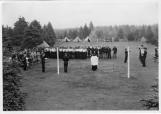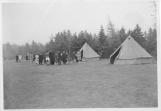14
Recruiting for the Royal NavyWe needed to do recruiting right away for the British services, so the chief of police became the recruiting officer and the assistant recruiting officer for the Royal Navy was Sergeant Mahoney of the Constabulary and Sergeant Mahoney, I recently saw a letter while researching my book, where the Navy people congratulated Sergeant Mahoney for the tremendous job he did early on at the recruiting until the British people came over from the British Navy and they could do it. So that alone was a tremendous working relationship you had the Chief of Police you had Sergeant Mahoney working exceptionally close and also my uncle, Sergeant Mac White was the Constabulary Drill Instructor and there was a bunch of Navy recruits that were here and they had a British Naval Officer coming over to inspect them before they went overseas, and Sergeant White, my uncle, the drill instructor, he got the men ready, the recruits and gave them drill and when the officer came over to inspect them he was quite impressed, and also Sergeant White from the Constabulary, these young recruits who were joining the Royal Navy, used to have to get their medicals and they used to march them up, they used to drill at police headquarters at Fort Townsend the old historic Fort Townsend and they would march the navy recruits from there up to Water Street west there was a naval recruiting center and they would have to get their medicals done and Sergeant White would have to march these guys back and forth so we're very proud the Constabulary of the relationship between the forces, especially the Navy and where we had these men, so I thought that was a really important role that they played in that liaison at the first part of the war until the British recruiters came over here.
Gary Browne
15
Crow's Nest, Water Street, Then and NowCirca 1942
St. John's, Newfoundland, Canada
 Credits:
Credits:Bill Guihan
Gary Browne
Jacquey Ryan
2007-2008 Album, Crow's Nest
16
While talking about the Caribou Hut which was the servicemen's hostel on Water Street east almost on the apron of the harbour and the security involved and the worry of the authorities about the information let out and the loose lips sink ships, I personally think the Crow's Nest played a very important key role there in the sense that the Caribou Hut was for non commissioned officers service men, naval ratings, the merchant marines, but the senior officers of the services, and especially the navy, because St. John's was so busy with the navy, they really had no where to go until I think Leonard Outerbridge made available the Crow's Nest club for them and I think this was really good because from what I know as a former member of the Crow's Nest, that it was a small place where these officers could go, these officers were under a lot of stress. They were responsible for corvettes and bigger navy vessels and they could go to the Crow's Nest, sit there and relax, and have a few drinks with other officers. I am sure during this time, because it was only a select group, you would have had to show who you were to get into the Crow's Nest, a lot more then the Caribou hut, (at the Caribou hut if you had a uniform on you could come in), but the Crow's Nest was invitation only and you had to prove who you were, so I could see the Crow's Nest giving these men who were under an awful lot of stress; a place to go relax and I am sure during times they would discuss in a sense like we're probably leaving tomorrow, or you're coming with us, or how long do you think it will take us to get over, or I hear there are a lot of submarines in this area, so they would have a less worry of having stuff get out because this was a select group and I think this was really important and at the same time it allowed these men a place to go relax and laugh and joke and have a few libations with one another and talk about home or whatever. So I think the Crow's Nest played a major important facet to these senior officers especially of course the Navy.17
Admiral Cuthbert Taylor in the Crow's NestCirca 1942
St. John's, Newfoundland, Canada
 Credits:
Credits:Royal Canadian Naval Photograph neg. #2-1616
Gary Browne
Jacquey Ryan
18
A major worry about there was the old term they used "loose lips sink ships" and because the Newfoundland Escort Force and the Canadian Navy were in St. John's, and it was so important and critica,l that they were really afraid of German's at the time because the German submarines were all around Newfoundland and they were after listening in to radios. I found research where the captain of one of the U-boats was listening to local radio stations in St. John's. He was that close hoping to hear someone say this vessel will be leaving tomorrow or someone saying goodbye to their loved ones who are heading overseas to join the British Navy. So they were actually listening in to the radio stations. So one of the big things that worried the security services, the constabulary had their own security division, Inspector Mahoney headed up, but they were worried about people talking and so were the military intelligence so the Government came out and notified all media and asked them would they put it in their papers, a cautionary notice asking people to be very careful not to discuss anything to do with shipping in the St. John's Harbour whether it was merchant marine, or was navy mention, nothing and you wonder why but they were afraid there were so many service men here. So Newfoundland then St. John's especially was full of strangers; the most common thing was a stranger in St. Johns, so if people were going into a hotel or were sitting in a coffee shop or they were out having some drinks with their friends, whether these guys be longshoremen, the authorities were afraid they were going to say "God the harbour is some busy tonight, I hear they are getting ,these ships, are moving out sometime tomorrow morning", so they were warning the people not to say or in any way draw attention to the harbour, troops, to movement of vessels, to anything. Tthey were really concerned because they thought there would be German spies and agents in St,. John' at the time and you got to remember there were neutral countries coming into St. Johns for the fishing trade. The Portuguese and Spanish and the Portuguese coming out of Lisbon, and Lisbon was the place where the highest concentration of German agents were in Lisbon and we had loads of Portuguese coming into our harbours. They were fishing off our Grand Banks and what was close to the Grand Banks was the Navy Convoy system that were going over to Britain. So they could find out anything, so its not only the German agents but there were also people here, it was proven ,there were German agents put on ships from neutral countries, so that whole "loose lips sink ships" we often see today in movies and we laugh about it and we see old posters but I can tell you from my father and people I talked to at the time, they were really scared and the authorities were really worried about people just dropping nonchalant hints and saying like you know there is a big troop movement going out tomorrow and my brother is on it and they were really afraid so they had to come out and warn people not mention anything about shipping in St. John's or soldiers or navy or what ships are in, so it was also a very interesting time.19
A Social Moment in the Crow's Nest Officer's ClubCirca 1943
St. John's, Newfoundland, Canada
 Credits:
Credits:2007-2008 Album, Crow's Nest
20
Vice Admiral E.R. Mainguy RCN, Co-Founder of the Crow's Nest Officer's ClubJuly 1951
St. John's, Newfoundland, Canada
 Credits:
Credits:Royal Canadian Naval Photograph, Neg. # NFLD> 683
22
Entrance to a a Snug Harbour, Interior of the Crow's NestCirca 1942
St. John's, Newfoundland, Canada
 Credits:
Credits:Royal Canadian Naval Photograph Neg #NF 3844-1
2007-2008 Album, Crow's Nest
23
King George the V Institute, Home of the Caribou HutCirca 1900
St. John's, Newfoundland, Canada
 Credits:
Credits:http;//www.kinggeorgevcondos.ca/history.html
Gary Browne
Jacquey Ryan
24
The soldiers, the navy guys, had a hard tough job to do and the merchant marine another group of people who saw probably more than anyone, of these terrible catastrophes at sea that they, (the constabulary), understood why they felt like they did and the tremendous stress they were under. And close by to the Crow's Nest was what they called the Caribou Hut, it was a hostel it was a place where so many of the naval ratings would come in and go; there were dances, a swimming pool, a library, places where they could write home in privacy and quietness and get away from it. That was a huge place right near the water front so a lot of the seamen would go there. But also in the Goulds which is 5or 6 miles out of St. John' s, there was a recreation area for the navy. And one would wonder why so far outside St. John's, but they wanted to get the navy boys away from the ships, away from the waterfront. Seeing-there were vessels coming in constantly that had been torpedoed so that wasn't much of a rest if you had that boat and they were seeing all this, but someone in their wisdom and it was, started this recreation camp for the navy and they could go out there; they had a movie theatre and a dance hall and again they could go out and relax and just get away from it. Just trying to remember what my father said, there was an extremely close working relationship between the constabulary and the navy here in St. John's.25
Aerial View of Donovans Rest CampCirca 1943
St. John's, Newfoundland, Canada
 Credits:
Credits:Royal Canadian Naval Photograph N.F. 3330
2007-2008 Album, Crow's Nest
26
Special Sunday Service at the Capt. D's Naval (Rest) Camp, DonovansCirca 1943
St. John's, Newfoundland, Canada
 Credits:
Credits:Harold J. Mitchell Collection
Royal Canadian Naval Photograph NF 2693
27
Visitor's Day Captain D's Naval (Rest) Camp, Donovan's1944
St. John's, Newfoundland, Canada
 Credits:
Credits:Harold J. Mitchell
Royal Canadian Naval Photograph, NF 2701
2007-2008 Album, Crow's Nest
